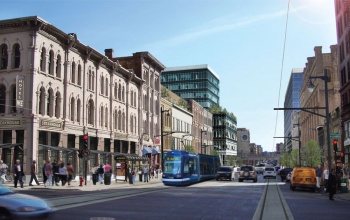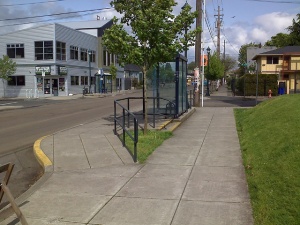Streetcar alternatives

|
This page is a "stub" - it needs more content.
You are invited to add your knowledge. Please contribute! |
Introduction
Thanks to the recent revival of neighborhoods served by streetcars in cities like Portland, Oregon, there’s a common conception that streetcars are a magic development bullet. The conventional wisdom suggests that the presence of “rails in the ground” sends a signal to developers that the transit infrastructure in question is permanent, while buses lack this sense of permanence. Like any claim of cause and effect, this assertion should be viewed skeptically on a number of grounds.
Foremost, new streetcars are typically accompanied with a number of other public investments in the street-scape that are independent from the vehicle technology, i.e. transit stop enhancements like improved shelters, signage and aesthetic features; these other investments could help explain investments by the private sector. Furthermore, many of these street-scape enhancements could be implemented just as easily to enhance existing bus service to obtain virtually all of the mobility benefits. Various treatments associated with BRT can provide a transit experience that is similar -- if not identical -- to streetcar service at a fraction of the cost of embedding rails in the streets and installing overhead wires.
Strategies
Right of way enhancements
Enhancements to the right-of-way in which the vehicle travels can improve the speed and comfort of the ride.
- Exclusive travel lanes principally reduce costs for agencies and improve service by allowing transit vehicles to bypass congested corridors without traffic delay. Transit-only lanes can also reduce conflicts between transit vehicles and other traffic, i.e. lane changes and turning movements.
- Transit signal priority (TSP) systems provide transit vehicles with preferential treatment at intersections, extending green lights for approaching transit vehicles and shortening red light cycles for stopped transit vehicles. The system typically works via transponders on transit vehicles that communicate the vehicle's position to the traffic signal.
Station stop enhancements
Enhancements to the transit stop/station can improve out-of-vehicle experience for transit users and increase the sense of permanence.
- Shelters and other street furniture provide a more pleasant waiting environment for transit patrons.
- Level boarding facilitates faster and easier boarding, especially for those with limited physical mobility.
- Curb extensions allows the bus to pick up and drop off passengers without having to pull out of and back into traffic.
Vehicle enhancements
Use of special vehicles
- Iconic vehicles and livery can help better brand bus service to make it more recognizable and legible to the community.
- Articulated buses can provide much of the capacity benefits of a streetcar.
- Alternative fuel vehicles such as Natural Gas or Electric Buses to reduce noise and/or emissions.
Service enhancements
Enhancements to the frequency and duration of service, or specialized routes to serve certain corridors.
- Increased frequency
- Increased span of service
- Specialized routes

